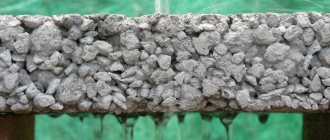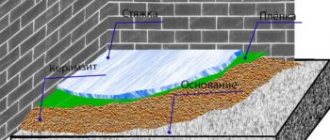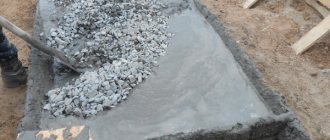To increase the service life of buildings, their foundations are protected from the effects of rain (melt) water using a blind area. It can additionally serve as a pedestrian path around the structure. Therefore, before carrying out construction work, it is necessary to select the optimal brand of concrete for the blind area, which is suitable both in price and in purpose.
Ready concrete blind area.
Why do you need a blind area
The blind area is a cement path adjacent to the building along the entire perimeter. It does not allow precipitation to pass through the ground to the foundation. Thanks to the blind area, the foundation is always dry, and the service life of the building increases.
If moisture enters the foundation, in winter it freezes and expands, and accordingly, destroys the concrete structure. Therefore, the blind area is a mandatory element when erecting buildings on foundations.
To create a high-quality blind area, it is recommended to use only concrete mixtures intended for use outdoors year-round. At the same time, its design must have sufficient width and thickness of the cement screed.
How to finish the finished structure?
To give the structure an aesthetic appearance, strengthen it and enhance its waterproofing qualities, you can decorate the surface. Options for finishing a cement blind area are:
- Coloring. Enamels and polymer paints intended for concrete surfaces are used after mandatory priming.
- Application of a protective composition . The use of Elakor will increase strength, reduce slipping, prevent dust and moisture, and add shine to the path.
- Ironing. This technique is performed dry or wet, and consists in applying dry concrete to the drying surface - it is spilled and leveled in an even layer. The surface becomes more durable, strong and rich in color.
- Impregnation. Application of a special composition, in finished form, can add shine to the surface and enhance its water-repellent qualities.
- Laying paving slabs . After the blind area has hardened, curbs are installed and tiles of any size, texture and color are laid, in accordance with construction laying rules.
Any of the selected methods can extend the life of the structure. Which one to choose is up to the individual to decide for himself.
Concrete composition: requirements and characteristics
The blind areas around the perimeter of buildings are unloaded concrete screeds. Such paths are not loaded daily with pedestrians and vehicles, so concrete grades with a minimum strength rating are used to fill them.
Basic requirements for street concreting:
- Water resistance of the surface of the blind area. Therefore, it is not recommended to use grade M50 (75) for the construction of blind areas, as they absorb moisture well.
- The cement mortar base must withstand the load of people walking on it, sudden temperature changes, and constant exposure to natural phenomena (rain, hail, snow, wind loads).
Proportions of concrete solution.
When calculating the amount of each component of the solution for pouring the blind area, the necessary indicators of the finished screed are taken into account: water resistance, frost resistance, strength. The higher these indicators are, the longer the operational period of the concrete structure.
Brand of concrete sweep
Technical characteristics and composition of the concrete mixture are established by GOST 7473-94 (9128-97). Grade is an indicator of the compressive strength of concrete.
When selecting a brand of concrete for pouring a blind area of a private house, it is necessary to take into account the further conditions of its operation:
- soil characteristics and climate in which the building is located;
- expected load on the cement surface.
Requirements for concrete that can be used for arranging the blind area of a country house:
- minimum grade - M200;
- minimum frost resistance - F150;
- minimum strength - B15.
This is one of the most popular building materials, which is used for arranging floor screeds, landings and steps, foundations and blind areas of buildings.
To prepare the cement mixture, cement M400 (500) is used.
If construction work is planned on heaving soils, the requirements for building materials increase by 1-2 points in all respects.
If in the region where the concrete structure is located there are significant temperature changes and a large amount of precipitation falls annually, it is better to use the M250 grade composition. Intermediate grade concrete can be used for the construction of lightly loaded structures and strip-type fences.
This material is resistant to cracking, heat and frost.
Concrete mortars of grade M300 (400) are used in the construction of multi-storey buildings and large production workshops. Large construction projects generate strong vibrations, under the influence of which low-grade concrete will quickly fail.
Concrete proportions
To calculate the volume of mortar for casting a blind area, it is necessary to multiply the dimensions of the structure: thickness, width and length.
When carrying out construction work, unexpected losses of mortar are possible, so it is recommended to increase the calculated value of its volume by 15%.
When producing branded concrete for casting a blind area, the components of the solution are taken in the following proportions:
- 1 part - cement;
- 3 parts - sand;
- 4 parts - crushed stones;
- 0.5 parts - water (the required volume of water will depend on the fraction of filler used - the larger the crushed stone, the less water).
If the proportions of the required components for a concrete mixture are converted into absolute values, then to produce 1 m³ of building material you need to use:
- 280 kg - cement grade M400 (the higher the grade of the component, the lower its consumption);
- 840 kg - sand (the sand is pre-washed and dried, it should not contain clay elements);
- 1400 kg - filler (it is recommended to use granite screenings with a grain fraction of 5-10 mm, having a cubic shape);
- 200 l - water.
The proportions of the components of the cement mixture are influenced by the brand of the binder component - cement.
Scheme of the blind area.
If Portland cement M300 is used to prepare M200 concrete mortar, then the proportion of components will be as follows:
- 1 part - Portland cement;
- 1.9 parts - sand;
- 3.7 parts - filler.
If M400 (a more durable composition) is used to make a similar building material, then the proportion will look like this:
- 1 part - cement;
- 2.8 parts - sand;
- 3.9 parts - filler.
To enhance the hydrophobicity of a concrete structure, polypropylene fibers or special plasticizers must be added to the solution.
Composition and technical characteristics of concrete.
Table: Proportions of M 400, sand and crushed stone for the production of different grades of concrete mixture.
| Concrete grade | M 100 | M 150 | M 200 | M 250 | M 300 | M 400 | M 450 |
| C:P:SH (kg) | 1:4,6:7,0 | 1:3,5:5,7 | 1:2,8:4:8 | 1:2,1:3,9 | 1:1,9:3,7 | 1:1,2:2,7 | 1:1,1:2,5 |
| P:SH (l) per 10l C | 41:61 | 32:50 | 25:42 | 19:34 | 17:32 | 11:24 | 10:22 |
| Concrete (l) from 10 l C | 78 | 64 | 54 | 43 | 41 | 31 | 29 |
The finished concrete mixture for pouring the blind area of a private house should be a homogeneous mass without lumps, similar in consistency to thick sour cream. To do this, when preparing the solution, you must follow the established sequence of actions:
- Clean water is poured into a concrete mixer (container for manual mixing).
- Cement is added in small portions and the mixture is mixed.
- After thorough mixing, when “milk” forms on the surface of the mixture, crushed stone can be added.
- After the crushed stone, dry sand is added, which must first be sifted so that there are no lumps.
- The last component that is added to the concrete solution is modifying additives.
- The solution is mixed until a homogeneous mass is obtained.
Component ratio
In addition to finding quality materials, it is equally important to then mix them correctly. And also make calculations of the required quantity. In order not to interrupt the important concreting process and not urgently purchase the missing items.
Proportions of concrete for the blind area of a house in parts:
- 1 – cement;
- 3 – sand;
- 4 – filler;
- ½ – water.
A cubic meter of 200 grade concrete will require 490 kg of M400 Portland cement. If the total area of the blind area is 20 m2, and its thickness is 15 cm, then you will need at least 3 cubes of ready-made mortar. And large volumes are easier to mix with a concrete mixer.
Many craftsmen are accustomed to calculating the proportions of concrete for the blind area in buckets. They make it easier to load a concrete mixer. And when using the latter, there is a little secret to obtaining a high-quality and plastic solution.
Ready-made concrete for blind area Source martand.ru
Waterproofing of concrete is important
When arranging a blind area around the house, you need to know that low grades of concrete have poor frost resistance and water resistance (the lower the grade, the worse the performance).
During the autumn rains, the soil collects a large amount of moisture and freezes in winter. For the foundation, such a phenomenon is detrimental. The water that has penetrated into the surface of the blind area in winter at subzero temperatures will begin to crystallize and increase in volume.
As a result, the concrete structure will crack and collapse.
Therefore, water resistance is an indicator that must be taken into account when choosing a brand of concrete for arranging a blind area around a private house. Durable, expensive grades of concrete have high water resistance.
The cost of concrete grade M400 is 1.3 times higher than concrete grade M100. But this building material has high strength characteristics, and it is not advisable to use it for arranging street paths that take on small loads.
What should the filler be?
To prepare concrete for a blind area you will need several components
- Cement;
- Sand;
- Crushed stone;
- Water.
When choosing fillers, you should consider the following aspects:
- It is recommended to use river sand. It must be free of foreign impurities in the form of clay, silt or other components that can reduce the strength of concrete;
- The crushed stone must be free of lime impurities. It is recommended to use crushed stone from 5 to 20 mm. It is allowed to use river gravel instead of crushed stone;
- To increase the plasticity of the solution, it is allowed to add plasticizers;
- It is recommended to use running water as a sealer.
To reduce the weight of the structure and increase the volume, expanded clay may be added. It is light in weight and is considered a good filler.
Low grade concrete: how to increase water resistance
To reduce the cost of the construction of the blind area, special additives are added to low-grade concrete that increase the water resistance index, or only the surface of the finished blind area is treated with such agents.
Penetron is a modern penetrating waterproofing used for moisture resistance of concrete surfaces.
The moisture resistance of a concrete screed over the entire thickness of the structure is increased by means such as Aquatron and Penetron. As a result of their interaction with the mineral substances of the solution, insoluble compounds are formed that block all the pores of the concrete.
The use of chemical additives increases the cost of a concrete structure, but not as when using expensive durable concrete.
A budget option for increasing the moisture resistance of a blind area is to iron its surface. In this case, the wet surface of the concrete screed is sprinkled with a 2-3 mm layer of pure cement and leveled using a construction trowel. This thin layer will have higher strength and moisture resistance. Such a concrete screed will be cheaper, but it is not durable.
To increase the service life of a concrete path around your own country house, it is recommended to use middle-class concrete with the addition of special water-repellent compounds. Additionally, it is possible to iron the finished concrete surface.
Application area
The design of the finish, namely its underlying layers, depends on geological conditions. It is necessary to take into account how the drainage is organized. It has many areas of application.
A simple blind area is used for dachas, estates and houses in the village. In order to strengthen the building in this way, a layer of crumpled clay is used, and then a hard covering is placed on it. Clay is an excellent waterproofing agent and provides good water drainage.
The cheapest coating is a layer of crushed stone.
Concrete blind area is a more expensive and durable option. It will allow you to control the level of precipitation and protect any structure from deformation.











